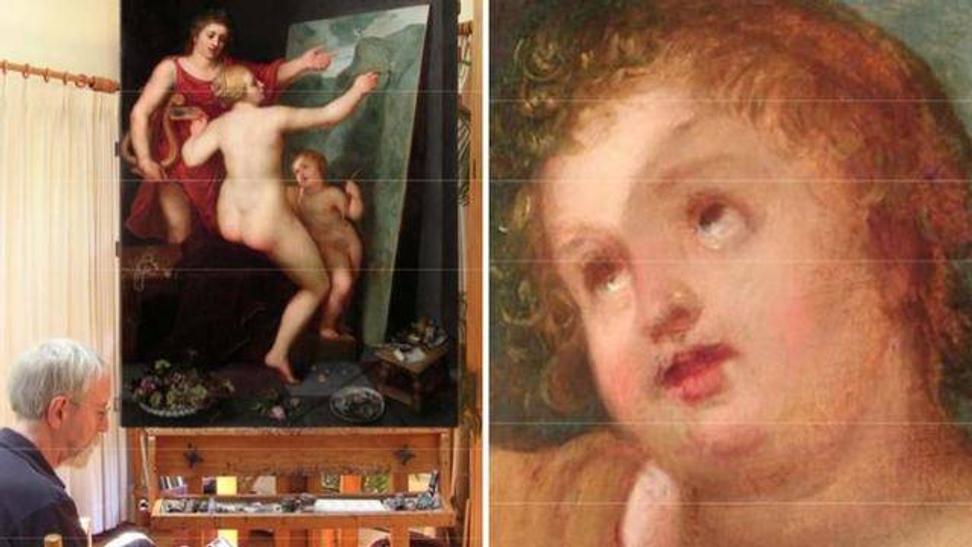Vatican Micromosaic of Saints Valeria and Martial
Everyone loves a good story. In the realm of fine art and antiques, a good story, or what we call “provenance”, has the power to take a work of art from exceptional to awe-inspiring.
In terms of workmanship, subject matter and sheer size,

this incredible micromosaic detailing the Biblical story of Saints Valeria and Martial has it all. Measuring over 10 feet tall, the precision and detail required to execute such a piece is baffling. Combined with the high cost of materials, micromosaics of this immense size and artistry are beyond rare.
When you factor in its provenance of being crafted by the prestigious Vatican’s Mosaic Studio and displayed in St. Peter’s Basilica, you’re dealing with an undeniable masterpiece of historical significance.
It took a team of seven skilled mosaicists over two and a half years to complete this majestic masterpiece. Given that Vatican relics, especially ones on such a grand scale as this, almost never leave the holy site, it is clear to discern that this is the most important artwork of its kind to come on the market in many years.
The micromosaic is based upon the 17th-century Baroque painting of the same subject that was created for St. Peter’s Basilica in 1627. That work hung above the holy site’s altar of St. Martial until 1824. This prompted cardinals and bishops from Limoges, France (where the saints depicted hailed) to tirelessly request for over 60 years to have the painting re-installed. By the time their request was given an audience, the painting had already found its way into an Italian museum’s collection.
Pope Leo XIII agreed to have the painting recreated in mosaic form and displayed where the original painting once hung.
A team of seven artisans, led by head Vatican mosaicist Salvatore Nobii, completed and installed the masterpiece in 1895. It was removed in 1963 and taken to the Vatican Mosaic Studio where it was prominently displayed for two decades. Eventually, Pope John Paul II gifted the mosaic to a very generous parishioner.
Pictured in author Frank DiFederico’s 1983 book The Mosaics of Saint Peter's: Decorating the New Basilica, this stunning tour de force is inscribed, including with the initials R.F.S.P.V. (Reverend Workshop of St. Peters) and dated. The only known work of its caliber not housed in a museum, this micromosaic brings new meaning to the term “masterpiece”.
Currently on offer at M.S. Rau Antiques, the Vatican Micromosaic of Saints Valeria and Martial along with numerous other treasures, is included (in giclée form) in the gallery’s latest exhibition Vice & Virtue: An Exhibition of Sex, Saints and Sin, open from April 7 – June 9, 2018.
Old Master painting, Otto van Veen’s discovered “Apollo and Venus” (Flemish, ca. 1600, unsigned).

Discovery
On February 12, 2016, Executive Director Robert Warren was looking for some Civil War flags and a staff member mentioned there was some collection material stored in a little-used storeroom under the auditorium’s second-floor balcony. For Hoyt Sherman Place, this was to become their “King Tut” moment. While looking for the boxes, Robert noticed a painting wedged between a table and the room’s plaster and lathe wall. (Image 1) Robert had just discovered a 400-year-old early Baroque panel painting. The Old Master painting had been “lost in the shuffle” for decades.
Description
The scene depicts the figures of Apollo and Venus accompanied by her son Cupid. Venus, the Roman Goddess of Love, Beauty, and Fertility, is portrayed as an artist painting a landscape that includes a small image of Pegasus on the horizon. Apollo, holding a lyre, is the Roman God of Music, Poetry, and more. Cupid is the Roman God of Desire, Affection, and Erotic Love. The painting also contains four still-lifes referencing Venus’ beauty and fertility: a collection of jewelry, a basket of fruit and flowers, a sprig of roses, and a bowl of oysters. A fifth still-life of her painting supplies occupies the lower right corner.
Condition
The painting was coated with layers of discolored varnish and former restoration work that flattened the three-dimensional quality of the scene and falsified the artist’s intended palette. Areas of former loss were present along splits in the wood and throughout scattered areas especially pronounced in the left third of the painting. The surface was heavily overpainted after a succession of former restoration attempts. (Image 2: Before Treatment)
Treatment
Four months of work were required to return the painting to its pristine visual appearance. The cleaning of a painting requires the use of organic solvents to swell and remove discolored films without injury to the paint surface. A background in chemistry is required for these procedures. This work is carried out under binocular magnification. The cleaning of the “Apollo and Venus” was a delicate process due to the painting’s overall instability and scale (H. 49 inches x W. 37 inches). The cleaning results were spectacular. (Images 3 and 4: During Cleaning)
Loose areas of paint were reset into place. Former losses were then filled and carefully retouched to match the original to both value and hue. A final non-yellowing varnish completed the treatment. (Image 5: After Treatment/In the Studio. Images 6 and 7: After Treatment Details)
Otto van Veen
Otto van Veen, also known by his Latin name Otto Venius or Octavius Vaenius, was born in Leiden around 1556. In 1574, he traveled to Rome for further study. Around 1580, he returned north. In 1592, van Veen settled in Antwerp. His presence there is verified from commissions he received for church altarpieces. He also oversaw a productive and vibrant studio with numerous students. His most famous pupil was Peter Paul Rubens who trained with van Veen from 1594 to 1600. He finally left Antwerp in 1615 and moved to Brussels, where he remained until his death in 1629.